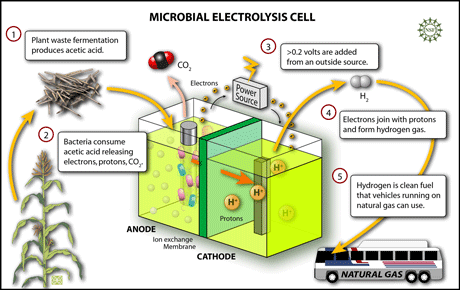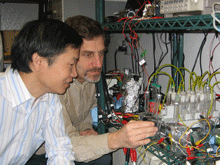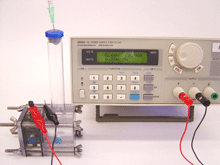Navigation
Microbes Churn Out Hydrogen at Record, New Efficient Rate
By adding a few modifications to their successful wastewater fuel cell, researchers have coaxed common bacteria to produce hydrogen in a new, efficient way.
 |
| Researchers have designed a microbial electrolysis cell in which bacteria break up acetic acid (a product of plant waste fermentation) to produce hydrogen gas with a very small electric input from an outside source. Hydrogen can then be used for fuel cells or as a fuel additive in vehicles that now run on natural gas. Credit: Zina Deretsky, National Science Foundation |
By adding a few modifications to their successful wastewater fuel cell, researchers have coaxed common bacteria to produce hydrogen in a new, efficient way.
Bruce Logan and colleagues at Penn State University had already shown success at using microbes to produce electricity. Now, using starter material that could theoretically be sourced from a salad bar, the researchers have coaxed those same microbes to generate hydrogen.
By tweaking their design, improving conditions for the bacteria, and adding a small jolt of electricity, they increased the hydrogen yield to a new record for this type of system.
 |
| Bruce Logan and Shaoan Cheng examining microbial electrolysis cells (MECs) in their laboratory at Penn State. Photo by David Jones |
"We achieved the highest hydrogen yields ever obtained with this approach from different sources of organic matter, such as yields of 91 percent using vinegar (acetic acid) and 68 percent using cellulose," said Logan.
In certain configurations, nearly all of the hydrogen contained in the molecules of source material converted to useable hydrogen gas, an efficiency that could eventually open the door to bacterial hydrogen production on a larger scale.
Logan and lead author Shaoan Cheng announced their results in the November 12, 2007, online version of Proceedings of the National Academy of Sciences.
"Bruce Logan is a clear leader in this area of research on sustainable energy," said Bruce Hamilton, National Science Foundation (NSF) director of the environmental sustainability program at NSF and the officer overseeing Logan's research grant. "Advances in sustainable energy capabilities are of paramount importance to our nation's security and economic well-being. We have been supporting his cutting-edge research on microbial fuel cells for a number of years and it is wonderful to see the outstanding results that he continues to produce."
Other systems produce hydrogen on a larger scale, but few if any match the new system for energy efficiency.
Even with the small amount of electricity applied, the hydrogen ultimately provides more energy as a fuel than the electricity needed to drive the reactor. Incorporating all energy inputs and outputs, the overall efficiency of the vinegar-fueled system is better than 80 percent, far better than the efficiency for generation of the leading alternative fuel, ethanol.
 |
| A microbial electrolysis cell (MEC) shown with the power source used to augment the voltage produced by the bacteria. Bacteria grow in the anode chamber, forming a biofilm on graphite granules, while hydrogen gas is released at the cathode and bubbles up and into the tube on top of the reactor. Photograph by Shaoan Cheng, Penn State University |
Even most electrolysis techniques, methods to extract hydrogen from water using electricity, pale in comparison to the new method.
"We can do that by using the bacteria to efficiently extract energy from the organic matter," said Logan. By perfecting the environment for the bacteria to do what they already do in nature, the new approach can be three to ten times more efficient than standard electrolysis.
Additional information about the new technology and how it works can be found in the Penn State press release at http://www.psu.edu/ur/2007/biohydrogen.htm.
See related coverage:
Fuel-Cell Microbes' Double Duty: Treat Water, Make Energy
Program Contacts
Bruce K. Hamilton, NSF (703) 292-8320 bhamilto@nsf.gov
Principal Investigator
Bruce Logan, Ph.D.
Director, H2E Center &
Engineering Environmental Institute
(814) 863-7908
www.engr.psu.edu/h2e/ [Hydrogen Energy (H2E) Center]
www.engr.psu.edu/eei (Engineering Environmental Institute)
www.engr.psu.edu/ce/enve/mfc-Logan_files/mfc-Logan.htm (microbial fuel cells)
See a working mfc in real time: www.engr.psu.edu/mfccam
Notes:
Available Dec 7: "Microbial fuel cells", by B.E. Logan, go to wiley.com
Microbial Fuel Cell Symposium, May 27-29, 2008, at Penn State University
Search
Latest articles
Agriculture
- World Water Week: Healthy ecosystems essential to human health: from coronavirus to malnutrition Online session Wednesday 24 August 17:00-18:20
- World Water Week: Healthy ecosystems essential to human health: from coronavirus to malnutrition Online session Wednesday 24 August 17:00-18:20
Air Pollution
- "Water and Sanitation-Related Diseases and the Changing Environment: Challenges, Interventions, and Preventive Measures" Volume 2 Is Now Available
- Global Innovation Exchange Co-Created by Horizon International, USAID, Bill and Melinda Gates Foundation and Others
Biodiversity
- It is time for international mobilization against climate change
- World Water Week: Healthy ecosystems essential to human health: from coronavirus to malnutrition Online session Wednesday 24 August 17:00-18:20
Desertification
- World Water Week: Healthy ecosystems essential to human health: from coronavirus to malnutrition Online session Wednesday 24 August 17:00-18:20
- UN Food Systems Summit Receives Over 1,200 Ideas to Help Meet Sustainable Development Goals
Endangered Species
- Mangrove Action Project Collaborates to Restore and Preserve Mangrove Ecosystems
- Coral Research in Palau offers a “Glimmer of Hope”
Energy
- Global Innovation Exchange Co-Created by Horizon International, USAID, Bill and Melinda Gates Foundation and Others
- Wildlife Preservation in Southeast Nova Scotia
Exhibits
- Global Innovation Exchange Co-Created by Horizon International, USAID, Bill and Melinda Gates Foundation and Others
- Coral Reefs
Forests
- NASA Satellites Reveal Major Shifts in Global Freshwater Updated June 2020
- Global Innovation Exchange Co-Created by Horizon International, USAID, Bill and Melinda Gates Foundation and Others
Global Climate Change
- It is time for international mobilization against climate change
- It is time for international mobilization against climate change
Global Health
- World Water Week: Healthy ecosystems essential to human health: from coronavirus to malnutrition Online session Wednesday 24 August 17:00-18:20
- More than 400 schoolgirls, family and teachers rescued from Afghanistan by small coalition
Industry
- "Water and Sanitation-Related Diseases and the Changing Environment: Challenges, Interventions, and Preventive Measures" Volume 2 Is Now Available
- Global Innovation Exchange Co-Created by Horizon International, USAID, Bill and Melinda Gates Foundation and Others
Natural Disaster Relief
- STOP ATTACKS ON HEALTH CARE IN UKRAINE
- Global Innovation Exchange Co-Created by Horizon International, USAID, Bill and Melinda Gates Foundation and Others
News and Special Reports
- World Water Week: Healthy ecosystems essential to human health: from coronavirus to malnutrition Online session Wednesday 24 August 17:00-18:20
- STOP ATTACKS ON HEALTH CARE IN UKRAINE
Oceans, Coral Reefs
- World Water Week: Healthy ecosystems essential to human health: from coronavirus to malnutrition Online session Wednesday 24 August 17:00-18:20
- Mangrove Action Project Collaborates to Restore and Preserve Mangrove Ecosystems
Pollution
- Zakaria Ouedraogo of Burkina Faso Produces Film “Nzoue Fiyen: Water Not Drinkable”
- "Water and Sanitation-Related Diseases and the Changing Environment: Challenges, Interventions, and Preventive Measures" Volume 2 Is Now Available
Population
- "Water and Sanitation-Related Diseases and the Changing Environment: Challenges, Interventions, and Preventive Measures" Volume 2 Is Now Available
- "Water and Sanitation-Related Diseases and the Changing Environment: Challenges, Interventions, and Preventive Measures" Volume 2 Is Now Available
Public Health
- Honouring the visionary behind India’s sanitation revolution
- Honouring the visionary behind India’s sanitation revolution
Rivers
- World Water Week: Healthy ecosystems essential to human health: from coronavirus to malnutrition Online session Wednesday 24 August 17:00-18:20
- Mangrove Action Project Collaborates to Restore and Preserve Mangrove Ecosystems
Sanitation
- Honouring the visionary behind India’s sanitation revolution
- Honouring the visionary behind India’s sanitation revolution
Toxic Chemicals
- "Water and Sanitation-Related Diseases and the Changing Environment: Challenges, Interventions, and Preventive Measures" Volume 2 Is Now Available
- Actions to Prevent Polluted Drinking Water in the United States
Transportation
- "Water and Sanitation-Related Diseases and the Changing Environment: Challenges, Interventions, and Preventive Measures" Volume 2 Is Now Available
- Urbanization Provides Opportunities for Transition to a Green Economy, Says New Report
Waste Management
- Honouring the visionary behind India’s sanitation revolution
- Honouring the visionary behind India’s sanitation revolution
Water
- Honouring the visionary behind India’s sanitation revolution
- Honouring the visionary behind India’s sanitation revolution
Water and Sanitation
- Honouring the visionary behind India’s sanitation revolution
- Honouring the visionary behind India’s sanitation revolution

